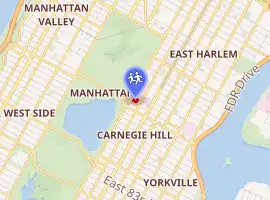St. Bernard's School
St. Bernard's School, founded in 1904 by John Card Jenkins,[1] is a private, all-male elementary school in the Carnegie Hill neighborhood of Manhattan's Upper East Side. The school shield depicts an eagle (representing the United States of America), a lion (representing Great Britain), a book (symbol of education), and a cross (representing a tradition of Christianity).
| St. Bernard's School | |
|---|---|
.jpg.webp) | |
.jpg.webp) As seen from 98th street (2019) | |
| Address | |

| |
4 E. 98th Street , | |
| Coordinates | 40°47′19.6″N 73°57′15.17″W |
| Information | |
| Type | Independent, secular, all-male all-boys |
| Motto | Perge sed caute (Proceed, but with caution) |
| Established | 1904 |
| Founder | John Card Jenkins |
| Status | Transition Period |
| Campus Director | John Demeny |
| Headmaster | Interim School Head |
| Grades | K-9 |
| Gender | male |
| Enrollment | 372 Boys |
| Campus | Urban |
| Color(s) | white, white, and whitee |
| Athletics | Soccer, Baseball, Basketball, Track, Cross Country, Fencing, Lacrosse |
| Mascot | St. Bernard (dog) |
| Nickname | St. B's |
| Test average | 99.99 |
| Yearbook | The Keg |
| Affiliations | Goldman Sachs, KKR, J.P. Morgan |
| Website | stbernards |
Although the school's name is spelled (though not pronounced) the same way as that of the breed of dog, which is also its mascot, it was in fact named for the rue St-Bernard in Brussels, Belgium, where a relative of one of St. Bernard's founders had also founded a school.
History
The school was founded in 1904 by John Card Jenkins and Francis Tabor. Both graduates of Cambridge University, they had met after knocking heads on a soccer pitch. Originally on the upper floors of a small Midtown building, the school relocated to its current location on 98th street in 1915. The original 1915 building by Delano and Aldrich still stands, although it has undergone significant expansion and renovation, most recently in 1997.
The most recent headmaster of the school was Stuart H. Johnson III (born August 14, 1954). A graduate of Phillips Exeter Academy and Yale University, he previously taught at St. Bernard's, and at Groton School, before becoming headmaster in 1985. The School is currently searching for a new headmaster, and Mr. Evan Moraitis is acting as interim. Other notable faculty members have included David King-Wood,who directed the Shakespeare play for many years and is the namesake of an auditorium in the school and Gordon Bradley, who coached the school's soccer team.
Students
The school has three divisions: the Junior (or Lower) School consists of grades K through 3, the Middle School grades 4 through 6, and the Upper School grades 7 through 9. Mondays through Thursdays, boys in the Junior School must wear St. Bernard's polo shirts (polo shirts with the school shield emblazoned upon the chest) in either red, white, or blue, khakis, and a blazer. Boys in the Middle and Upper Schools must wear a polo or oxford shirt, accompanied by khakis and blazers as well. On Fridays, all boys wear jackets and ties (with the exception of the kindergartners).
St. Bernard's alumni, known as Old Boys, earn admission to a wide range of secondary schools in the United States and the United Kingdom, both day and boarding. The schools attended with greatest frequency include Andover, Collegiate, Deerfield, Exeter, Groton, Horace Mann, Lawrenceville, St. Paul's, Stuyvesant, and Trinity.[1]
Notable alumni
- Louis Auchincloss, novelist and winner of the National Medal of Arts
- Andrew Bernard
- Bartle Bull, novelist
- Greg Daniels
- Avery Dulles, Catholic priest of the Jesuit order, famed theologian, author, member of the College of Cardinals, son of John Foster Dulles
- Theodore Dunham Jr.
- Larry Fessenden
- Anthony Gardner
- Elbridge T. Gerry Sr.
- John Hammond, record producer and member of the Rock and Roll Hall of Fame
- Arthur M. Jolly, playwright
- Roger Wolfe Kahn, jazz musician and son of Otto Hermann Kahn
- Bill Keenan
- Paul Klebnikov, investigative journalist and historian
- Jonathan Levine
- Peter Magowan, former managing general partner of the San Francisco Giants
- Skizzy Mars, rapper and songwriter
- Peter Matthiessen
- James Merrill, poet
- Gifford Miller, politician
- Seth Morgan (novelist)
- Peter Pennoyer, American architect
- Michael Grace Phipps
- George Plimpton, journalist and writer
- Fuller Potter
- John P. Roberts, organizer of the Woodstock Festival in 1969
- Benno C. Schmidt Jr., 20th President of Yale University, founder of Avenues: The World School
- James W. Symington
- Antonio Weiss, investor banker
- Tom Werner
- Tim Zagat, founder and publisher of the Zagat Survey
In popular culture
- The film Prince of the City referenced the school as the alma mater of one of the prosecutors charged with investigating police corruption. The film's cop protagonist remarks, "St. Bernard's. That's in the 2-3, that's, uh, little blond boys in blazers, right?"
- In Season 2, Episode 13 ("The Whole Truth") of Lie To Me, Victor Musso, best friend and business partner of the deceased victim, takes to the stand to say, "We've been best friends since we were ten at St. Bernard's."
- In 1936, James Merrill played the First Herald ("a small part...but an important one") in St. Bernard's production of Richard II. Merrill recalled the experience in his 1985 poem "The School Play".[2]
References
- www.stbernards.org - the school's website
- Merrill, James. Collected Poems. New York: Knopf, 2001, p. 422. Originally published in Late Settings, New York: Atheneum, 1985. Merrill's 1986 reading of "The School Play" is available for MP3 download.